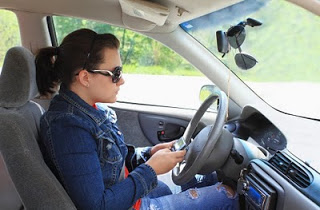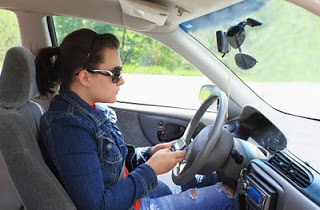Tag Archive: teens and distracted driving

What is being done to Stop Distracted Driving?
October 12, 2010
Each day there is more research conducted, articles written and information available about the dangers of distracted driving. This increase in awareness is highlighting the growing problem all drivers face on the roadways. Distracted driving has been estimated to cause over 11,500 deaths in the last two years. But what has been done to eliminate the problem? What initiatives are organizations and individuals doing to combat distracted driving?
Forming Organizations
When you Google “distracted driving groups” you will find varied results of individuals banding together to increase awareness on distracted driving, on a local or country-wide basis. The organizations can be as simple as asking people to pledge against distracted driving, like Oprah’s No Phone Zone, or wearing thumb socks to show a driver’s support for not texting while driving. These groups establish their presence online, in various social networking services, making it easier to distribute the message.
Enacting Laws
With the nationwide awareness on the shocking statistics of texting while driving, the Federal, state and local governments and municipalities have proposed and enacted laws to prohibit cell phone usage while on the road. So far, more than 30 states have a law that places a ban on texting while behind the wheel, urging drivers to think twice before they pull out their phones. The type of penalties and amount of fines range from location to location. Currently, the options are being weighed on how to effectively further enforce texting ban laws.
Phone/Text-blocker apps
How to stop phone use while on the road? Simple. Install a phone/text-blocker application. These applications interface the cell phone to the vehicle’s Global Positioning System (GPS) to see if the car is in motion. If so, the application disables the cell phone’s call and/or texting features. With crash-risk increasing four times/talking on the phone and 23 times/texting, it can help discipline the driver into not relying on their phones so much while on the road, until they break the habit.
Mock Crashes
Several local/teen driving advocacy groups have set up mock crashes to remind teen drivers (the group most likely to engage in texting while driving) what could potentially happen if they text and drive at the same time. In most places, the mock crashes are set up at the entrance of the school depicting the wrecked cars, actors as teen drivers, playing dead with phone in-hand. It is a shocking, yet accurate statement that reminds teen drivers of the potential consequences.
Trial Runs
There are also trial course runs, usually hosted by a state’s Division of Motor Vehicles along with several advocates against distracted driving. They allow drivers to experience firsthand what could happen should they attempt to text while driving. Set in an enclosed space, with only traffic cones as obstacles and are operated at low speeds. These courses are designed to show drivers that they are unable to handle both tasks, by challenging them to maneuver their vehicle safety and skillfully while driving distracted.
Advertising and Videos
Various organizations release ads that are either funny or serious in order to make their point. Some organizations do their advertisements a step above by involving the people themselves. They create contests asking drivers if they have what it takes to get the message across, in a video format. The advantages of these types of contests include maintaining a limited budget, creating enthusiasm, spurring creativity and raising safety awareness in teen drivers.
People are motivated to change their behavior in different ways. One or all of these approaches can be incorporated to stop distracted driving. Take a proactive approach to know the dangers and help stop distracted driving.

Measures Taken to Stop Distracted Driving
May 5, 2010
Each day, as it seems, more and more information about the dangers of distracted driving comes out — which increases the awareness of drivers about the growing problem. But what has been done? What exactly are organizations and individuals doing to combat distracted driving?
Forming Organizations
When you Google “distracted driving groups” it will yield several results — of individuals banding together, increasing awareness on distracted driving, on a local or country-wide basis. These can be as simple as asking people to pledge against distracted driving, like Oprah’s No Phone Zone, or wearing thumb socks to show a driver’s support for not texting while driving. These groups establish their presence online, in various social networking services, making it easier for their targets to get the message.
Enacting Laws
With the nationwide awareness on the shocking statistics of texting while driving, local governments have acted to put in motion laws that would prohibit cell phone usage while on the road. So far, more than 30 states have a law that places a ban on texting while behind the wheel, urging drivers to think twice before they pull out their phones, unless they want a penalty. For now, the options are being weighed on how to effectively enforce texting ban laws — but public support usually wins, and a law is enacted.
Phone/Text-blocker apps
Stopping phone use while on the road? Simple. Install a phone/text-blocker app. These applications interface the phone to the car’s GPS and if it sees that the car is in motion, the app disables the phone’s features. With crash-risk increasing 4 times/talking on the phone and 23 times/texting — it may help discipline the driver into not relying on their phones so much while on the road, until hopefully, they won’t have a need for such an application anymore. Learn more about apps like this including http://www.Textecution.com/.
Mock Crashes
Several local/teen driving advocacy groups have set up mock crashes to remind teen drivers (the group who are most likely to engage in texting while driving) what could potentially happen if they text and drive at the same time. In most places, the mock crashes are set up in a way that, the first things that teens going to school are going to see are wrecked cars, teen-drivers-playing-dead-with-phone-in-hand and lots of fake blood. It is a shocking, yet accurate statement that would inform teen drivers of the potential consequences.
Trial Runs
There are also trial runs — usually hosted by a state’s DMV along with several advocates against distracted driving — they allow drivers to experience firsthand what could happen should they attempt to text while driving. Set in an enclosed space, with only traffic cones as obstacles, there are only a few who manage to get through the course without hitting any of the cones while texting/driving. There are drivers who believe they are perfectly capable of handling both tasks, but running through a trial distracted driving course more or less proves them otherwise.
Ads
Various organizations would release ads that are either funny or serious in order to make their point. Some organizations do their advertisements a step above by involving the people themselves — they create contests asking drivers if they have what it takes to get the message across, in video form. Which is a good thing — it awakens an enthusiasm and awareness in teen drivers — which makes them think about safety when driving.
Distracted Driving Courses
The addition of cell phones, texting and driving, in-vehicle video entertainment, and navigation systems lengthens the long list of driver distractions. Research reveals that many new drivers do not recognize the risk of these activities when driving. To make teen drivers more aware of the risks there are courses like Dangers of Distracted Driving. The course creates a clear understanding of the distractions while driving and how they can cause crashes and cost lives.

Reaching for Items in Your Vehicle and Distracted Driving
October 26, 2009
The hazard drivers create when they text or talk on cell phones has received considerable attention in the popular press recently. However, a more common distracted driving hazard is reaching for an item in the vehicle. Though cell phone use while driving is a significant problem, National Highway Traffic Safety Administration (NHTSA) studies indicate that it is a relatively small proportion of the distracted driving issue.
Driving distractions occur anytime something takes your eyes off the road, your hands off the steering wheel, or your mental attention from the task. Some distractions involve two or even all three of these. When you look for a particular song on a CD or MP3 player, your eyes turn from the road ahead, you remove at least one hand from the steering wheel, and you are temporarily preoccupied by the task of searching for the song you want to hear.
Other “reaching” distractions include:
- Eating
- Smoking
- Manipulating the controls of the aforementioned stereo, an in-vehicle navigation system or the climate control system
- Reaching for a fallen object
NHTSA estimates that drivers participate in potentially distracting activities about 30% of the time their vehicles are moving. Distraction may result in:
- loss of vehicle control
- unintended speed changes
- leaving the lane of travel
- missed opportunities to respond to changes in the driving scene
Though a motor vehicle crash caused by a driver reaching for something in the vehicle is not easily proved unless the driver admits to it, most drivers are aware of having driven while distracted by reaching for something in the vehicle.
“Reaching for something” does not have to mean reaching for an inanimate object. When they reach out to soothe, protect or discipline their children and pets, drivers’ attention is removed from the driving scene. Driving requires all your concentration, and parents should teach their children this and reinforce the lesson when necessary. Children should be fastened into appropriate safety restraint systems. While distractions aren’t good for you as a driver, they are great for children as passengers; DVDs, books, games, and small toys can keep them occupied until you reach your destination. If your children need attention, find a safe place to pull off the roadway. Your furry friend can travel safely in a pet carrier or safety harness. Never let your pet ride in your lap or roam around the vehicle while you drive.
Other ways to manage distractions include adjusting all of the vehicle’s controls before you start to drive and during stops at traffic lights, asking passengers to assist you when you need to get something inside your vehicle, and taking breaks to eat, drink and smoke.
Learning how to manage the distraction of reaching for things in your vehicle is a daunting task because it occurs so frequently. But doing so will allow you to keep you, your passengers, and other road users safe when you’re behind the wheel.

Top 3 Most Dangerous Cities for Teen Drivers are in Florida
August 29, 2009
Two studies, one by Allstate Insurance Company and the other by Reader’s Digest, indicate that geography plays a part in teens’ risk of injury and death in motor vehicle crashes. And because of their age group, teens are already at great risk. The number one killer of American teens is motor vehicle crashes; one study shows that the problem is particularly serious in Florida. Every year, over 5,000 people aged 16-20 are killed in motor vehicle collisions, according to the National Highway Traffic Safety Administration.
The ten riskiest cities out of the 50 largest urban areas in the US were selected using statistics from the national Census Bureau, federal crash data, and company claims information on teen passenger vehicle collisions. The most dangerous US cities for teen drivers are Southern, with the top three in Florida. Of the top 50 cities in the country for teen fatality crashes, Tampa/St. Petersburg/Clearwater, Orlando/Kissimmee, and Jacksonville rank number one, two and three, respectively.
The analysis by Reader’s Digest categorizes states according to their current Graduated Driver’s Licensing (GDL), seat belt, and Driving Under the Influence (DUI) laws. According to the study, Alaska, California and Delaware rank as the top three; three of the worst states include North Dakota, Mississippi and Arkansas. Florida is categorized as “Fair,” the next-to-lowest ranking. Interestingly, California cities also scored high in the Allstate study: San Francisco/Oakland, San Jose, and Los Angeles were numbers one, two, and four.
Factors that contribute to teen motor vehicle crashes include:
- Speeding/driving too fast for conditions -Driver distraction, including cell phone use and dealing with passengers -Inexperience -Driving at night -Driving under the influence of alcohol or drugs (including prescription and over-the-counter drugs)
- Teens also often neglect to wear their seat belts, increasing the risk of serious injury or death in a crash. An observational study by the Utah Department of Health found that the teen seat belt use rate falls when other high-risk factors are present, such as when teens drive under the influence of alcohol, drive at night, have multiple teen passengers, or are driving without a driver’s license.
The risk factors listed above, including seat belt requirements, are addressed by GDL laws in many states. Before advancing to the next phase of licensure, young drivers must show progress by complying with specific restrictions. Driver education was a part of the curriculum in 90% of US high schools during the 1980s; in 2009, only 20% do. GDL laws are of increasing significance in the effort to reduce teen crash rates, because teens get most of their driver training from their parents and are often subject only to state requirements after licensure.
While a national model for GDL laws has existed since the mid-1990s, no state follows all of the requirements. To show the disparities among states, The National Safety Commission (TNSC) analyzed the GDL laws in four states: California, Florida, Mississippi, and North Dakota.
- The minimum age for a learner’s permit in California is 15 years, six months; the minimum age is 15 in Florida and Mississippi. In North Dakota, the minimum age is 14.
- While California and Florida each require 50 hours of practice driving with a parent or guardian in the learner’s permit stage, 10 hours of which must be at night, neither Mississippi nor North Dakota require parental certification of any driving practice hours.
- North Dakota does not have any passenger or nighttime restrictions, and Florida and Mississippi have only nighttime restrictions. California’s passenger restriction is that for the first 12 months, the restricted driver may have no passengers younger than 20, with limited exceptions for immediate family.
Comprehensive GDL laws reduce deaths among 16-year-old drivers by 38%, according to a study by Johns Hopkins University for the AAA Foundation for Traffic Safety; the Reader’s Digest study also supported the idea that better GDL laws mean that fewer teens will die in motor vehicle crashes. However, TNSC points out that parents must actively participate in their teens’ driver education by enforcing GDL laws as house rules, rather than leaving the issue to law enforcement. The possibility of legal consequences for teens who don’t abide by their state’s GDL laws should serve as support for parental restrictions, not take the place of them.
How Active Participation Helps Teens Understand Safe Driving Concepts
August 4, 2009
Most adults understand that teens tend to tune out long lectures about safe driving (or anything else), but parents and teachers also know that they have important messages to pass on, and they are sometimes at a loss as to other methods of doing so. Creative thinking in terms of teaching methods, both in the home and at school, can mean the difference between messages that teens will ignore versus those they will integrate into their driving behavior. This is so important with driving; motor vehicle crashes are the leading cause of death for teens in the United States, according to the National Highway Traffic Safety Administration. Obviously, lectures aren’t working.
Recently, First Coast News of Jacksonville, FL profiled four teenagers who had created a Public Service Announcement (PSA) to promote safe driving. The PSA shows a teen driving while listening to music, eating, and using a cell phone to talk and text; she eventually glances at the road just in time to see that it’s too late to avoid a motor vehicle crash.
Reporters quizzed the teens on whether or not they’d ever performed any of these unsafe driving behaviors. The teens admitted to doing so but also said that making the PSA had heightened their awareness of how dangerous these behaviors are, which had caused them to curb the behavior. The teens said that creating the PSA had made the consequences of distracted driving, such as getting into a crash and being seriously injured, seem real. This is more of an accomplishment than one might think; teens’ brains are not biologically developed enough for them to control impulses and understand the consequences of their behavior, which is why convincing them to drive safely is such an uphill battle.
Another benefit of this type of active participation is that these teens became positive role models for their peers, influencing them to drive more safely. Peer pressure is a reality that must not be ignored; many teens perform more (both in intensity and in number) risky driving behaviors when they are accompanied by teen passengers. Whether the teen driver is bowing to external pressure from friends or internal pressure to show off, the effect is the same. The key is not to try to convince teens to disregard peer pressure, an almost impossible task, but to convert the peer pressure into a positive influence.
Making the PSA also had the effect of helping these teens take responsibility for their driving behavior. Again, this is typically a difficult task. Teens have a variety of sources, legitimate and irrational, to blame for their poor choices; reaching maturity means accepting responsibility for their decisions and the attendant consequences, along with realizing that they are the ones who make the ultimate decision to be safe drivers.
Listening to a lecture is a passive process; making a PSA is an active process because it forces the teen to engage with and think about safe driving concepts. Of course, having every teen in America make a PSA about safe driving would be a logistical nightmare, and due to teens’ short attention spans, the experience would soon wear thin. But the concept of having teens participate in an active learning process about safe driving could be utilized in every household and in every school.
Before assigning an active-participation project to teens, consider their interests. Most teens love music, popular television shows, being with friends, and talking about themselves. Most teens are self-conscious about their appearance and are interested in grooming, clothes, and accessories. Many teens also have a special hobby, such as gaming, art, computers, writing, or sports. Many are also interested in exploring new ideas – the perfect time to let them get creative with how to disseminate safe driving messages. Ideas include:
- Designing a poster or series of posters
- Writing a song, using computer software to write accompanying music
- Writing an episode of their favorite television show
- Performing a skit with friends
- Giving their own “presidential address”
- Designing a clothing/accessory line
- Creating a video game
To avoid boredom, vary the topics assigned to the teen, but for maximum benefit, assign topics that relate to common teen driving mistakes, such as:
- Drinking and driving
- Drugs and driving (focus on common drugs of abuse for teens, such as cough medicine, prescription drugs, inhalants, and marijuana)
- Wearing safety belts
- Speeding
- Reckless driving, such as weaving in and out of traffic
- Aggressive driving, such as tailgating
- Distracted driving, such as cell phone use
- Driving with passengers
To further engage their critical thinking skills, have teens present their messages from other points of view. For example, teens who are interested in politics can give a presidential address about enacting laws to lower teen deaths in motor vehicle crashes; teens who are interested in sports can create an advertising campaign showing how drinking and drugs can impair athletic ability. Until the project is finished, try to provide encouragement and support without too much assistance; let teens follow the research and learning process to its logical conclusion.
Helping teens engage in an active learning process regarding safe driving behavior is a requirement for reducing the teen death rate on our nation’s roadways.
